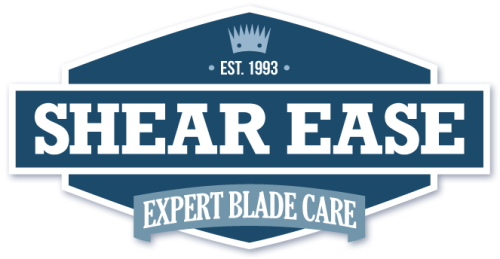Looking after your clipper blades
It is essential that clipper blades should be looked after properly, as not only does it affect the life of your blades, but more costly, the life of your clipper. Proper care will help keep your clipper blades sharper for longer and will dramatically reduce wear and tear on your clipper. The cost of good quality clipper blade oil and the time it takes to care for your blades is tiny compared to the potential repair costs resulting from poor maintenance.
Effective care consists of 1. Cleaning your blades, 2. Oiling your blades and, 3. Storing your blades properly.
You will need:
An oil soaked cloth, clipper blade oil, 2 small containers and blade wash of some description.
1. CLEAN YOUR CLIPPER BLADES.
Firstly, clipper blades need to be cleaned periodically while clipping. There is no point in lubricating a dirty, gritty blade; it will still go blunt quickly!
Remove excess fur and grit from around the blade with a stiff brush (similar to a toothbrush). You can blow excess fur from the blade, but expect to get a fair share in your face! Here at Shear Ease we have an air compressor that we use. We don’t expect most people to have one but if you do have one, use it, if you don’t use a stiff brush!
Using something like blade wash. (Something like! It’s not THAT important, washing up liquid and water will do fine) Using a small container, create a pool deep enough to immerse the blades (AND ONLY THE BLADES!). Turn the clipper on, with blade attached. Run the blade in the pool of whatever liquid you choose to use. You should see tiny bits of fur washing from in between the teeth of the blades. Depending on the build-up, the blades should start to run more freely, causing the motor to run slightly easier and quicker.
Wipe the back of the blade with an oil soaked cloth and then follow steps below for oiling them quickly and thoroughly.
“As well as cleaning blades during clipping, blades should be thoroughly cleaned after clipping.”
It is possible to take clipper blades apart, this will enable to clean your blades very well, but is time consuming and if you not sure how to put them back together properly, you may end up stopping the blade working totally! We will soon have a video guide showing you how to re assemble a clipper blade but until then, just in case, don’t take them apart unless you know what you are doing!
The idea is to remove any kind of grit, fur and build up from the cutting surfaces of the blades. Use anything such as washing up liquid, blade wash, plain water. Use a stiff brush (an old toothbrush is ideal) to brush any or all of the above from the cutting surfaces. Slide the comb to one side, clean both cutting services, slide the comb the other way and do the same again.
Blades used for surgery would need to be disinfected in the same way as any surgical instrument.
DO NOT LEAVE BLADES WITHOUT OIL AFTER CLEANING! YOU MAY RETURN IN A DAY OR SO TO FIND SPECKS OF RUST ON YOUR BLADES! CLEANING YOUR BLADES IS JUST THE FIRST THING TO DO. CLIPPERS MUST BE PROTECTED FROM RUST (WITH OIL) STRAIGHT AFTER CLEANING.
2. KEEP BLADES LUBRICATED AT ALL TIMES
Oil means less friction. Less friction means less heat. Excess heat can cause clipper rash and an unhappy animal! Friction also causes blades to go blunt quicker.
Good quality clipper oil is best. Most clipper manufacturers have their own clipper blade oil. Use this. Many people use WD-40 as a convenient alternative. As a spray, WD-40 is too thin and evaporates quickly. Oil can be used as an effective wash, WD-40 in spray can form cannot be effective as a wash and actually fur and dirt stick to it, having an adverse effect. WD-40 in a pot, used as a dunk is no good either. WD-40 is so thin it gets into the mechanisms of a clipper and washes out heavy grease in time. This will destroy clipper in time.
If you are in a situation where the amount of oil you use doesn’t bother you, then, using a small container, create a pool deep enough to immerse the blades (AND ONLY THE BLADES!). Turn the clipper on, with blade attached. Run the blade in the pool of oil.
If you wish to conserve your oil, tip some in between the teeth and at the back of the cutter while the blade is running, basically wherever the two blades come in contact with each other.
Do not leave the clipper blades to soak in blade wash because of the high water content, try to wipe the clipper blade dry as much as possible.
3. STORING YOUR BLADES
After being washed and lubricated for the final time before storing them, they should be wrapped in an oil soaked cloth and stored in a moisture free area. If a blade goes rusty, it WILL go blunt VERY quickly. Rust won’t be any good in a surgical environment either.
Following the steps above WILL PROLONG clipper and blade life, however, it will not make them immortal! When they eventually go blunt and stop working, send your blades to us for our Clipper Blade Sharpening service.
NEED MORE HELP OR ADVISE? ASK A TECHNICIAN
